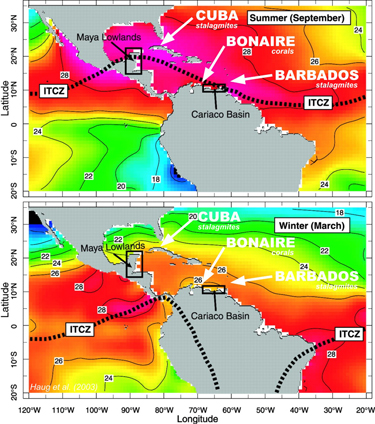|
Control of seasonality and interannual to centennial climate in the Caribbean during the Holocene - Combining coral records, stalagmite records and climate models Principal Investigators: Thomas Felis (University of Bremen), Augusto Mangini (HAW Heidelberg), Denis Scholz (HAW Heidelberg), Gerrit Lohmann (AWI Bremerhaven) Project Scientists: Claudia Fensterer (HAW Heidelberg), Cyril Giry (University of Bremen), Wei Wei (AWI Bremerhaven)
Seasonal variations in the mean position of the Intertropical Convergence Zone (ITCZ) over the Caribbean region, illustrated for typical summer (September) (top) and winter (March) (bottom) conditions. These variations control the pattern and timing of regional rainfall. Numbers and colours reflect sea surface temperatures in degrees Celsius. Locations of the study areas (Bonaire, Cuba, Barbados) and the Cariaco Basin and Maya Lowlands are indicated. Figure and legend modified from Haug et al. (Science, 2003). The project CaribClim will identify forcing mechanisms of seasonality and interannual to centennial climate variability in the Caribbean region during the Holocene, by analysing fossil corals from Bonaire and stalagmites from Cuba and Barbados, combined with climate model simulations. Based on oxygen isotope and Sr/Ca variations in corals, sub-seasonally resolved reconstructions of changes in both hydrologic balance and temperature at the sea surface will be generated for specific time intervals. Based on oxygen isotope variations in stalagmites, reconstructions of summer rainfall intensity in near-decadal resolution will be generated over several millennia. State-of-the-art climate models will be used to simulate Holocene climate evolution over several decades to millennia. Simulations of the hydrologic cycle (oxygen isotopes) and surface temperature will identify forcing mechanisms responsible for changes in seasonality and interannual to centennial climate observed in the marine and terrestrial archives, which will be accurately dated by the 230Th/U method. The approach will quantify the natural range of climate on these timescales, and will unravel the role of El Niño-Southern Oscillation, Atlantic Multidecadal Oscillation, North Atlantic Oscillation and variations in insolation and Atlantic thermohaline circulation in the observed changes. This will contribute to successful predictions of future Caribbean climate.
Quantitative and semi-quantitative paleo-temperature and paleo-hydrology reconstructions (seasonality, interannual to centennial variability), U-series dating, coupled climate modelling (including oxygen isotopes) Archives Marine archive: annually-banded reef corals (Bonaire), terrestrial archive: cave stalagmites (Cuba, Barbados)
Publications Fensterer, C., D. Scholz, D. Hoffmann, A. Mangini, J.M. Pajón (2010) 230Th/U-dating of a late Holocene low uranium speleothem from Cuba. IOP Conference Series: Earth and Environmental Science, 9, 012015, doi:10.1088/1755-1315/9/1/012015. Fensterer, C., D. Scholz, D. Hoffmann, A. Mangini, J.M. Pajón (2010) 230Th/U-dating of a very young, low U stalagmite from Cuba. PAGES news, 18(1), 47. Giry, C., T. Felis, S. Scheffers, C. Fensterer (2010) Assessing the potential of Southern Caribbean corals for reconstructions of Holocene temperature variability. IOP Conference Series: Earth and Environmental Science, 9, 012021, doi:10.1088/1755-1315/9/1/012021. Giry, C., T. Felis, S. Scheffers, C. Fensterer (2010) Monthly Holocene temperature variability from Caribbean corals. PAGES news, 18(1), 49.
|
| < Prev | Next > |
|---|


